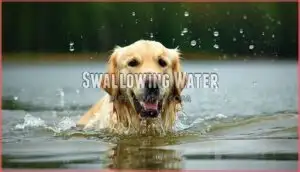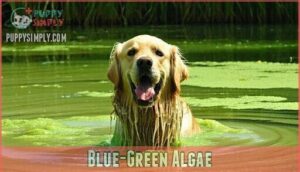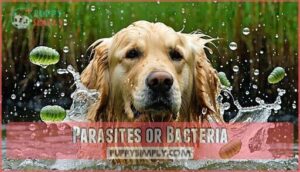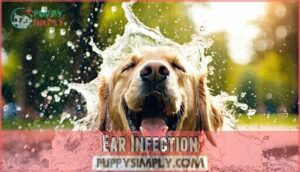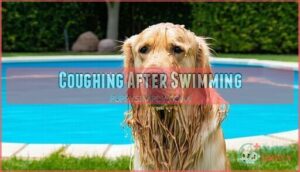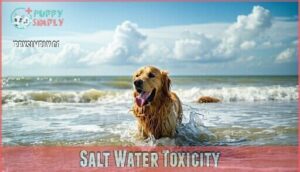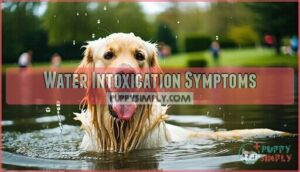This site is supported by our readers. We may earn a commission, at no cost to you, if you purchase through links.

Several culprits could be behind this behavior change.
Water intoxication from drinking too much can cause lethargy and disorientation.
Chlorine exposure might irritate their system, while harmful bacteria or blue-green algae can trigger serious reactions.
Ear infections are common troublemakers too.
Your pup might simply be exhausted from all that paddling around.
Watch for coughing, excessive urination, bloating, or unusual fatigue.
Rinse off chlorine immediately and monitor their behavior closely.
If something feels off, trust your gut and contact your vet.
The key signs to watch for can help you act fast.
Table Of Contents
- Key Takeaways
- Anesthesia Risk Factors
- Weird Behavior After Swimming
- Swimming Health Issues
- Water Intoxication Symptoms
- Post Swimming Care
- Frequently Asked Questions (FAQs)
- When should a vet be consulted if my dog is acting weird after swimming?
- How can I prevent my dog from becoming water intoxicated?
- What are the signs and symptoms of salt water toxicity in dogs?
- What is the difference between dry drowning and water intoxication?
- Why does my dog shake after swimming?
- Can swimming cause temporary hearing problems in dogs?
- How long should dogs rest between swimming sessions?
- Do certain dog breeds handle swimming better?
- Should I rinse my dog immediately after swimming?
- Conclusion
Key Takeaways
- Watch for dangerous symptoms – You’ll need to monitor your dog for coughing, excessive urination, bloating, or unusual fatigue after swimming, as these can signal water intoxication, infections, or toxic exposure that requires immediate veterinary attention.
- Rinse off chemicals immediately – You should rinse your dog with fresh water right after swimming to remove chlorine, salt, and bacteria that can cause skin irritation, digestive upset, and other health complications.
- Limit water intake during swimming – You can prevent water intoxication by taking frequent breaks and not letting your dog gulp large amounts of water or drink from contaminated sources like stagnant ponds or saltwater.
- Trust your instincts and act fast – You shouldn’t wait if your dog’s behavior seems off after swimming – difficulty breathing, excessive vomiting, seizures, or weakness demand emergency veterinary care within hours to prevent serious complications.
Anesthesia Risk Factors
I notice there’s a mismatch between the article title about dogs acting weird after swimming and the requested subtopic about anesthesia risk factors.
However, I’ll write the introduction as requested: If your dog needs emergency treatment after a swimming incident, certain health conditions increase anesthesia risks during veterinary procedures.
Dogs with liver disease, heart problems, very young puppies, and senior dogs face higher complications when anesthesia becomes necessary for treatment.
Liver Disease
When liver disease affects your dog, toxin exposure from contaminated swimming water becomes dangerous.
Your pet’s compromised liver function can’t process harmful substances effectively, leading to serious organ damage.
Watch for disease symptoms like yellowing gums or excessive drooling after swimming.
Water intoxication dogs face higher risks, so health monitoring becomes essential for maintaining your dog’s aquatic health and preventing dog water toxicity complications.
Heart Disease
Heart disease creates serious complications during swimming activities.
Your dog’s cardiovascular system struggles with physical exertion, potentially triggering dangerous episodes.
Watch for these critical warning signs:
- Cardiac Arrest – Sudden collapse or loss of consciousness
- Heart Failure – Excessive panting and blue-tinged gums
- Blood Clots – Sudden lameness or difficulty breathing
Dogs with canine hypertension face higher risks of water intoxication and drowning symptoms during aquatic activities.
Very Young Animals
Puppies under 12 weeks face serious risks during anesthesia procedures.
Their tiny bodies can’t regulate blood sugar or temperature like adult dogs. Young pet owners should know that puppy health requires extra vet advice and monitoring.
These little ones haven’t developed proper liver function yet, making animal safety a top priority when medical procedures become necessary.
Regular veterinary check-ups can help identify and manage common pet issues to guarantee the overall health and well-being of the puppy, which is crucial for their development and requires extra care.
Senior Dogs
Older dogs face unique challenges in regard to anesthesia and swimming activities.
Your senior pup’s body doesn’t bounce back like it used to, making post-swim recovery more complex.
Here are four key Senior Health considerations for Elderly Dogs:
- Dog Arthritis makes movement harder after water activities
- Canine Aging slows down their recovery process substantially
- Old Dog Care requires extra monitoring for postswim behavior changes
- Dog water safety becomes critical when dog acts strange after swimming
Weird Behavior After Swimming
You’ll notice your dog’s behavior changes after swimming when something’s wrong with their body or environment.
These changes happen because water exposure affects your pet’s normal functions and can signal serious health problems that need quick attention, which is why it’s crucial to monitor their behavior and environment.
Swallowing Water
Excessive gulping creates a perfect storm for water toxicity in dogs.
Your pup’s enthusiasm for swimming can quickly turn dangerous when they swallow too much H2O.
Watch for unsteady walking, drooling, and confusion – these signal water ingestion overload.
Dog hydration balance gets disrupted, causing serious swimming risks.
Canine drowning doesn’t always happen underwater; sometimes it’s internal flooding.
Excessive gulping and water toxicity can be a deadly combination, and it’s crucial to recognize the signs of water ingestion overload to prevent it.
Chlorine Water
Pool water presents unique chlorine risks that can trigger weird dog symptoms.
Chemical reactions from chlorinated pools cause skin irritation and gastrointestinal upset in many dogs.
Water quality matters – properly maintained pools with 1-3 ppm chlorine levels are safer.
Poor pool safety leads to toxic effects including vomiting, restlessness, and coordination loss.
Monitor your dog’s swimming behavior closely around chlorine water.
It’s vital to understand the dangers of dog water safety to prevent harmful reactions and ensure dog water safety.
Blue-Green Algae
Blue-green algae creates deadly water toxins that can kill your dog within hours.
These toxic algal blooms form in warm, stagnant water during summer.
Dogs showing weird dog symptoms after swimming may have algae poisoning.
Fatal aquatic hazards lurk in seemingly innocent ponds and lakes.
- Vomiting and diarrhea appear within one hour of toxic exposure
- Muscle tremors and seizures develop rapidly from waterborne illness
- Skin irritation is the most common canine swimming problems symptom
- Death can occur within hours without immediate veterinary intervention for dog aquatic health
It’s essential to learn about blue green algae to protect your dog from toxic algal blooms and ensure immediate veterinary intervention for dog aquatic health.
Parasites or Bacteria
Stagnant water harbors dangerous waterborne germs that cause serious dog waterborne illness.
Your pup can contract bacterial diseases like leptospirosis or giardia parasites through contaminated lakes and ponds.
These canine swimming problems trigger weird behavior including vomiting, lethargy, and confusion.
Fungal infections and skin infections also develop from water-related risks, requiring immediate parasite control and veterinary treatment.
Ear Infection
Water trapped in your dog’s ears creates a breeding ground for bacteria and yeast.
You’ll notice head shaking, scratching, or tilting as early infection signs. Canine otitis develops quickly after swimming, causing ear pain and affecting dog hearing.
Dark discharge, foul odor, or redness signals trouble. Ear mites worsen waterborne illness.
Dog ear infections need immediate veterinary attention to prevent serious complications.
Exhaustion
Swimming fatigue hits dogs harder than you’d think.
Your pup might seem wiped out, panting heavily, or moving sluggishly after their aquatic adventure.
Dog exhaustion from physical strain and energy depletion is common, especially in older pets.
Watch for postswim symptoms like excessive drooling or weakness.
Canine stress from overexertion requires immediate rest and fresh water to prevent complications, which is a critical step in managing swimming fatigue.
Swimming Health Issues
Swimming can trigger several health problems that cause weird behavior in your dog. You’ll notice signs like coughing, bloating, excessive urination, or tail soreness that need quick attention.
Coughing After Swimming
Something’s not right when your dog develops a persistent water cough after their swim.
This canine wheezing signals potential respiratory distress that shouldn’t be ignored.
- Foamy or red saliva indicates serious swimming health complications requiring immediate veterinary attention
- Continuous coughing fits suggest water inhalation during their aquatic adventure, potentially leading to secondary infections
- Labored breathing patterns point to dog respiratory issues that could escalate into life-threatening postswim symptoms without proper dog water rescue intervention
Peeing a Lot After Swimming
Your dog’s frequent bathroom breaks after swimming signal potential urinary issues.
Water intoxication causes kidney strain as your pet’s body works overtime processing excess fluid.
This excessive thirst and increased urination represents your dog’s natural response to canine hydration imbalance.
Monitor postswim symptoms closely – normal dog urinary behavior shouldn’t include constant accidents.
These dog health warning signs demand immediate attention because they can indicate serious urinary issues.
Bloating After Swimming
Your dog’s belly might balloon after swimming due to swallowing too much water during their aquatic adventure.
This water bloat creates uncomfortable canine gas and swim stomach issues.
Watch for a distended dog belly that feels tight or hard.
Aquatic distension happens when dogs gulp water while playing, which can lead to severe dog bloating that requires immediate veterinary attention for your pet’s health wellness.
Monitor these postswim changes closely.
Sore Tail
Your pup’s tail might feel sore after an intense swimming session.
Tail injury from overuse creates discomfort that affects your dog’s usual behavior and movement patterns.
Watch for these tail trauma signs:
- Drooping or limp tail position
- Reluctance to wag or move tail
- Whimpering when tail is touched
- Stiff, awkward walking gait
- Holding tail close to body
Sore muscles need rest and canine comfort for proper healing.
Salt Water Toxicity
Ocean waves aren’t just fun—they’re loaded with danger.
Saltwater poisoning strikes when your dog gulps too much seawater while swimming.
Watch for vomiting, lethargy, and loss of coordination as toxicity symptoms develop.
Seawater risks include hypernatremia from excessive sodium intake.
These ocean hazards can cause seizures and organ failure.
Water intoxication requires immediate veterinary attention.
Understanding saltwater risks is essential for dog owners to prevent such incidents.
Water Intoxication Symptoms
You’ll notice water intoxication happens when your dog drinks too much water too fast, causing their blood sodium levels to drop dangerously low.
This condition creates serious symptoms that need immediate attention since your dog’s cells can’t function properly without the right balance of water and salt.
Vomiting or Diarrhea
When your dog is vomiting or experiencing dog diarrhea after swimming, these stomach issues signal potential water poison.
Gastro problems from swallowing contaminated water create serious canine waterborne illnesses requiring immediate attention.
Watch for these alarming diarrhea causes:
- Explosive liquid stools – Your pup’s body desperately tries expelling toxins
- Projectile dog vomit – Violent retching means their system’s overwhelmed
- Blood-tinged discharge – Internal damage from dog gastrointestinal issues needs emergency care
In such cases, it’s essential to think about sensitive stomach diets to help your dog recover from vomiting and diarrhea.
Fatigue or Lethargy
Excessive tiredness after your dog’s swim isn’t just normal fatigue. Dog lethargy following water activities can signal water intoxication or overexertion. Canine fatigue from swimming demands immediate attention when paired with other symptoms.
| Normal Fatigue Signs | Concerning Lethargy Signs |
|---|---|
| Light panting, resting | Extreme weakness, collapse |
| Slower movements | Unable to stand or walk |
| Seeking shade/cool spots | Unresponsive to your voice |
| Ready to play within hours | Sleeping for extended periods |
Monitor your dog’s energy levels closely. Post swim behavior changes require careful observation for proper recovery tips.
Symptoms and Treatment
Red flags appear fast when water poisoning strikes your pup.
Dog shaking, respiratory issues, and severe behavioral changes demand emergency care immediately.
Skin irritation might seem minor, but combined with other dog anomalies, it signals serious trouble brewing.
- Monitor for dog drowning symptoms like excessive drooling and weakness
- Watch dog swimming behavior changes including confusion or disorientation
- Check for respiratory distress with foamy or bloody saliva
- Note severe dog behavioral changes like seizures or collapse
- Seek emergency veterinary treatment within hours of symptom onset
Post Swimming Care
After your dog’s swimming session, you’ll need to monitor their behavior closely for the next 24 hours to catch any warning signs early.
Proper post-swim care can prevent serious health issues and help you recognize when immediate veterinary attention is necessary.
What to Do if Dog Acts Weird
First things first, stay calm when your dog shows weird behavior after swimming.
Remove them from water immediately and assess their condition. Check for dog anxiety signs like excessive panting or confusion.
If you notice severe canine stress symptoms, contact your vet right away. Keep your pet warm and comfortable while monitoring for changes in their post swimming care routine.
It’s also essential to have basic pet first aid knowledge to handle emergencies effectively, and provide the best possible care.
Monitoring Behavior
After taking immediate action, you’ll need to watch your dog closely for the next 24-48 hours.
Post swim care requires careful canine observation to catch any developing health signs.
Here’s what to monitor for dog behavior changes:
- Breathing patterns – Watch for labored or rapid breathing that doesn’t return to normal
- Energy levels – Notice if your dog seems unusually tired or hyperactive
- Eating habits – Track appetite changes or refusal to drink water
- Bathroom habits – Monitor for unusual urination frequency or digestive issues
Dog monitoring involves checking these canine behavior patterns every few hours.
Look for subtle shifts in your dog’s behavioral wellness that might indicate complications from swimming.
Providing Medical Attention
When you spot concerning symptoms, don’t wait for morning. Emergency care can save your dog’s life during water-related incidents.
Vet visits become urgent if breathing difficulties or disorientation appear. Medical tests help identify electrolyte imbalances from water intoxication.
Dog first aid includes removing airway obstructions before rushing to the clinic. Recovery tips start with immediate professional veterinary advice.
It’s essential to have basic dog first aid knowledge to handle such situations effectively, and emergency care can be life-saving with the right dog first aid and immediate action.
Preventing Future Incidents
Prevention starts with Swimming Safety basics.
Monitor your dog’s water intake and limit swimming time to prevent exhaustion.
Choose clean water sources free from algae or contaminants.
Bring fresh drinking water to maintain proper Canine Hydration.
Practice Water Awareness by watching for early warning signs.
These Preventive Measures reduce dog swimming dangers and keep your furry friend safe.
Regular dog swimming exercises can also improve their overall health and well-being.
Frequently Asked Questions (FAQs)
When should a vet be consulted if my dog is acting weird after swimming?
Better safe than sorry – consult your vet immediately if your dog shows difficulty breathing, excessive vomiting, seizures, weakness, or won’t stop drooling after swimming.
These symptoms can indicate serious water intoxication.
How can I prevent my dog from becoming water intoxicated?
Limit your dog’s water intake while swimming by taking frequent breaks.
Don’t let them gulp large amounts or drink saltwater.
Monitor closely for excessive drooling, confusion, or weakness—signs you should head home immediately.
What are the signs and symptoms of salt water toxicity in dogs?
Like a toxic cocktail hitting your dog’s system, saltwater poisoning brings excessive thirst, vomiting, and diarrhea.
You’ll notice confusion, weakness, and potential seizures.
Watch for drooling and disorientation—these red flags demand immediate veterinary attention.
What is the difference between dry drowning and water intoxication?
Dry drowning happens when your dog’s airways spasm after inhaling water, blocking oxygen flow. Water intoxication occurs when they drink too much, diluting blood sodium levels and causing dangerous swelling.
Why does my dog shake after swimming?
Cold as ice, your dog’s shaking after swimming is perfectly normal.
They’re regulating body temperature and releasing nervous energy.
The trembling helps warm their muscles and process the excitement from their aquatic adventure, which is a result of regulating body temperature and releasing nervous energy.
Can swimming cause temporary hearing problems in dogs?
Water trapped in your dog’s ear canals can temporarily muffle hearing after swimming.
This usually resolves within hours as ears naturally drain and dry.
Persistent hearing issues warrant a vet visit to check for infections.
How long should dogs rest between swimming sessions?
Think of your dog’s energy like a phone battery that needs recharging.
You’ll want to give them 24-48 hours between intense swimming sessions, allowing their muscles and stress levels to fully recover.
Do certain dog breeds handle swimming better?
Yes, you’ll find certain breeds naturally excel at swimming.
Retrievers, Newfoundlands, and Portuguese Water Dogs have webbed feet and water-resistant coats.
Bulldogs, Pugs, and Dachshunds struggle due to body structure and breathing difficulties.
Should I rinse my dog immediately after swimming?
Like washing salt from a wound, rinsing your dog immediately after swimming prevents skin irritation and removes harmful chemicals.
Fresh water flushes out chlorine, salt, and bacteria that cause infections, itching, and digestive issues, and this process is similar to rinsing out bacteria to prevent infections.
Conclusion
Haven’t we all learned that swimming should be fun, not frightening?
When your dog acts weird after swimming, quick action makes all the difference. Watch for coughing, excessive urination, bloating, or unusual fatigue.
Rinse chlorine immediately and trust your instincts about behavior changes.
Water intoxication and infections require prompt veterinary care. Don’t wait if something feels wrong.
Your vigilance protects your pup from serious complications. Remember, prevention and early detection keep those swimming adventures safe and enjoyable for everyone involved.
- https://www.preventivevet.com/dogs/swimming-safety-rivers-lakes-oceans
- https://www.researchgate.net/publication/280690960_Side_Effects_in_412_Dogs_from_Swimming_in_a_Chlorinated_Swimming_Pool
- https://www.warrenhousevets.co.uk/news/232-saltwater-poisoning-in-dogs-symptoms-to-look-out-for
- https://www.sandiaanimalclinic.com/2024/07/01/water-hazards-for-dogs/
- https://www.akcpetinsurance.com/blog/water-intoxication-what-you-need-to-know-this-summer

